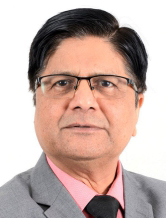|
 Mr. Amit
Dave
M. Pharm, MBA,
Former CEO - Brazil Operations/ Vice President Export
– Zydus Cadila/Claris Lifesciences |
Country Profile
Motivated to write about Peru since the author had
also spent quite some time in Peru, a South American
country, during his recent visit to the region.
 |
Peru is a fairly
large country in the region. The population of the country
is 34 million (compared to 11 mn in DR and 17.5 mn in
Guatemala). This extreme western country in South America
(please see the map) has thick jungles, beautiful Andean
mountains, and also the world-famous Machu Picchu, “the
lost city of the Incas”, in these mountains. The capital
city is Lima. This country’s official language is Spanish.
The economy of Peru is the
forty-seventh largest economy in the world based on total
GDP. The country also has a high Human Development Index.
Post-Covid, the economy was projected to grow at a rate of
more than 9%!! Peru is the third largest economy in the
region of South America (after Brazil, and Argentina).
Interestingly, Peru boasts one of the highest average life
expectancies in the region (77 years).
Like most of the other South American countries, Peru
has signed several free trade agreements, including the
one with China (China–Peru Free Trade Agreement),
besides agreements with the United States, Japan, and
the European Union. Readers know that these treaties
cover almost all the countries that are the major
players in the medical devices sector. One interesting
and important point is that Peru imports more than 97
percent of its medical devices. This point adds to the
attractiveness of the market.
Peru Highlights
• Very high import dependence for medical devices
• Regulatory Framework almost like the other counties
• A large Indian population involved in the healthcare
market
• Larger market with better realization
Regulatory Framework and Product Classification
DIGEMID is the regulatory agency for Peru and their
website (all contents in Spanish) is
www.digemid.minsa.gob.pe/webDigemid/. This webpage
has a facility for autotranslation and readers are
encouraged to visit and study the webpage for more
clarity. Law 29459 (Law of Pharmaceutical Products,
Medical Devices, and Health Products) covers the
regulatory framework. This Law 29459 describes the
document requirements, application evaluation timelines,
and surveillance obligations to apply for sanitary
registration.
It is generally observed that in a geographical region,
medical devices product classifications are almost
similar. So, like DR and Guatemala, Peru also has four
classes for medical devices.
• Class I : Low risk (and need general controls).
• Class II : Moderate risk (requiring controls during
the manufacturing).
• Class III : High risk (and call for controls in design
and manufacturing), and
• Class IV : Critical in terms of risk, and special
controls in the design and throughout the manufacturing
process.
An overseas manufacturer needs to obtain a sanitary
registration for the importation, marketing, and
distribution of medical equipment and devices in Peru.
Registration certificate is always issued in the name of
a local importer or distribution partner since the rules
do not allow foreign manufacturers to be the owners of
product registrations. A clear legal
contract/documentation between the parties is,
therefore, recommended.
Peru Medical Devices Market
Different estimates by different market research
agencies give the market size between 400 mn to 500 mn
USD. The growth rate is estimated at about 6% per year.
The readers will immediately realize that the market
size is very high on a per-capita basis if compared with
other countries in the region (as well as with India).
Dependence on imports is very heavy, as stated in the
beginning.
For medical devices, the Peruvian market has five buyer
segments-
1. Public hospitals which serve 60% of the population.
These hospitals fall under MINSA (local health
ministry). Mostly, their buying is through open tenders
2. The national social security agency (El Salud). They
attend to the rest of the 40% population.
3. The military
4. The police department
5. The private sector
The private sector is growing mainly because of the
growing middle class with more disposable income.
Because of longer life expectancy, the elderly
population is also seen increasing. Such factors make
the last segment attractive. Typically, a large
distributor has teams that take care of each of these
segments. However, the first two are quite important,
though highly cost sensitive. The type of products also
decides the segment selection for an exporter.
Opportunities and Challenges
A larger market size comparatively, because of the
factors listed above, longer life expectancy resulting
in the larger elderly population and increasing private
market offer a good opportunity. Prioritization for
digitization and telemedicine also provides a newer
segment opportunity.
The registration process and steps are almost like that
in the other counties in the region. An Indian exporter
can prepare documents common for more than one country
of the region. Like other countries, here also, the
challenges could be language and distance.
A very large population of Indians residing in the
country (mainly in Lima) can be a good support system.
In the healthcare profession, there are many Indian
operators. The author had an opportunity to meet many of
them during a function of the recent festive season, and
their enthusiasm as well as local contacts were found to
be quite impressive. These people can be effective and
reliable partners and can solve many challenges. |
